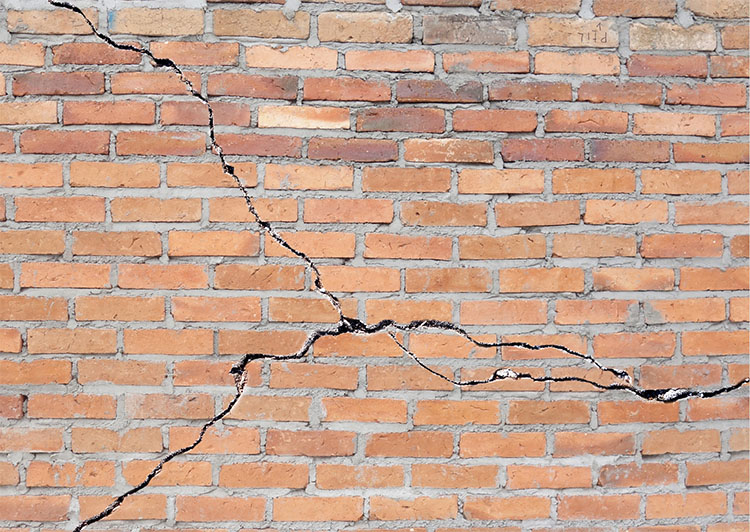Bowing Basement Walls: Your Comprehensive Guide
Bowing basement walls present a silent but significant challenge to the structural integrity of a home. These deviations from the normal plane of basement walls occur when external forces exceed the strength of the wall material, causing it to curve inward. This guide elucidates the phenomenon, sheds light on the gravity of the issue, and underscores the urgency of addressing it before minor warping escalates into a full-blown structural failure.
Neglecting bowing basement walls can precipitate a cascade of detrimental effects, ranging from minor cracks that mar aesthetic appeal to severe structural damage that can compromise the safety of the entire building. Such neglect can result in exorbitant repair costs, plummeting property values, and in extreme cases, the evacuation of the premises for safety reasons.
Protect Your Walls from Weather Damage—Call Our Experts Today!
Identifying Bowing Basement Walls
Early detection of bowing walls can mitigate risks and reduce the need for more complex repairs. Homeowners should regularly inspect their basement walls for signs such as horizontal cracks, inward bulges, or inward movement at the top or bottom of the wall. Another telltale sign is the separation of the basement wall from floors and ceilings.
Common causes behind the bowing of walls include hydrostatic pressure from soil saturation after heavy rains, expansive clay soils that swell with moisture variations, and frost heave in colder climates. Additionally, construction oversights or aging materials may play a role.
To accurately gauge wall curvature, homeowners can employ tools like a plumb bob, laser level, or even a simple visual inspection aligned with a straight edge. For precise measurements, however, professional instruments and expertise are often required.
The Impact of a Bowing Basement Wall on Your Home
A bowing basement can lead to significant structural risks if not remedied in a timely fashion. As the wall bulges inward, the risk of sudden failure increases, particularly under the added stress of heavy rains or flooding. This structural compromise can lead to water ingress, fostering mold and mildew growth that pose health risks and damage to interior finishes and personal property.
Beyond health and property damage, a bowing basement wall can considerably devalue a property, turning off potential buyers or leading to reduced offers. Additionally, safety becomes a primary concern, as the structural integrity necessary to support the home is jeopardized.
Immediate Steps to Take
Take note of any visible cracks, bulging, or signs of moisture around the bowing area. Document the damage with photos to help professionals assess the problem and monitor its progression. The best thing to do is call a contractor, let them inspect for leaks, pooling water, or moisture issues that may contribute to hydrostatic pressure and give you recommendations and solutions to repair the wall and ensure it doesn’t happen again.
Comparison of Professional Bowing Wall Repair Methods
Addressing the complexities of bowing basement walls requires a spectrum of repair methods, each tailored to the specific condition of the wall and the external pressures applied to it.
Common professional methods include
Wall anchors are a trusted solution for restoring stability to bowing walls. This method uses heavy-duty anchors attached to the exterior soil and interior wall plates, effectively counteracting the lateral pressure causing the bowing.
Benefits:
- Enhanced Stability: Wall anchors strengthen and stabilize walls by applying counter-pressure, preventing further movement.
- Versatile Solution: Suitable for various soil conditions and wall types, offering flexible application.
- Cost-Effective: A less invasive and affordable alternative to full wall reconstruction.
- Long-Term Durability: Designed to maintain structural stability over time when installed correctly.
For a non-invasive and modern approach, carbon fiber straps provide a sleek yet powerful way to reinforce bowing walls. These high-strength straps are bonded to the wall using industrial-grade epoxy, adding immense strength without disrupting your home’s aesthetic.
Benefits:
- Low-Profile Solution: Carbon fiber straps are nearly invisible once installed, maintaining the visual integrity of your walls.
- Superior Strength: Stronger than steel, these straps prevent further wall movement effectively.
- Quick Installation: Minimal labor is required, reducing installation time and disruption.
- Non-Invasive Repair: No need for exterior excavation, making it a clean and efficient solution.
Steel I-beams have been a cornerstone solution for severe bowing walls. These vertical supports are installed to provide reinforcement, ensuring the wall withstands immense lateral pressure while regaining its structural integrity.
Benefits:
- Maximum Reinforcement: I-beams offer unmatched strength for walls with significant bowing or structural compromise.
- Proven Reliability: A time-tested method trusted by professionals for decades.
- Adjustable Over Time: Some installations allow for gradual tightening to further correct wall alignment.
- Ideal for Severe Cases: Perfect for homeowners needing reinforcement for heavily compromised walls.
Underpinning is a method used to fortify a foundation by extending its depth or breadth. This redistributes the structure’s load, alleviating pressure on bowing walls and providing a more stable footing for the entire home.
Benefits:
- Enhanced Foundation Stability: Extending the foundation ensures better load distribution, reducing stress on walls.
- Long-Term Solution: Addresses underlying causes of wall bowing, such as soil instability or shifting.
- Customized to Your Needs: Can be tailored to address specific issues, from poor soil conditions to weakened foundations.
- Prevention of Future Problems: A proactive solution that safeguards your home from further structural issues.
Each method has its own set of advantages and scenarios for application, often determined by a foundation specialist.
Case Study Highlight: Foundation Wall Repair in Islip, NY
When a homeowner in Islip, NY faced severe water intrusion and structural damage across 90 linear feet of cinder block foundation walls, Zavza Seal LLC provided a comprehensive solution. By combining advanced drainage installation, vapor barrier application, and reinforced concrete belt construction, we restored the foundation’s structural integrity and eliminated water intrusion risks. This project not only secured the home against future environmental stresses but also reinforced the foundation to make it stronger than ever before.
Want To Learn More? Explore Our Case Studies Page Here.
Repairing Bowing Walls: DIY vs. Professional
DIY solutions for bowing walls often result in inadequate repairs that fail to address the root cause of the problem. Without the proper assessment and tools, temporary fixes can lead to greater damage and higher costs in the long run. Additionally, the absence of professional warranties on DIY repairs can be a significant drawback.
When to Call in Professionals
Professional intervention is recommended when:
- Bowing exceeds ½ inch.
- Cracks are wide, numerous, or increasing in size.
- Water leakage accompanies the bowing.
- The structure’s integrity is visibly compromised.
Zavza Seal’s Expert Repair Services for Bowing Walls
Zavza Seal provides professional assessments and tailored for bowing basement walls, backed by up to 30-year warranties. Our commitment to excellence ensures peace of mind and a long-term resolution to foundation issues.
Prevention and Maintenance: Strategies to Prevent Walls from Bowing
Preventative measures include:
- Maintaining moisture levels around the foundation to minimize soil expansion and contraction.
- Implementing proper landscaping to ensure water flows away from the home.
- Installing effective drainage solutions like French drains or exterior waterproofing.
Routine Maintenance Tips to Strengthen Basement Walls
Regular maintenance should involve:
Inspecting and cleaning gutters and downspouts.
- Checking for and sealing minor cracks before they expand.
- Monitoring interior humidity levels to prevent condensation.
Importance of Proper Water Drainage and Ground Grading
Proper water drainage and ground grading are crucial in alleviating hydrostatic pressure against basement walls. Ensuring the ground slopes away from the foundation at least 10 feet can prevent water from accumulating near the home and exerting pressure on the basement walls.
Cost to Repair Bowing Basement Walls
When facing the prospect of repairing bowing basement walls, understanding the financial implications is crucial for homeowners.
Factors Affecting the Cost of Repairs
The cost of repairing bowing basement walls can vary significantly based on several factors:
- Extent of Damage: Minor bowing with few cracks is less expensive to repair than severe bowing.
- Repair Method: Different techniques, from wall anchors to carbon fiber straps, vary in cost.
- Accessibility: Difficulty in accessing the repair site may result in higher labor costs.
- Material Costs: Price fluctuations for steel, carbon fiber, and concrete can affect the overall cost.
- Regional Factors: Labor costs and building codes differ by region, impacting the total repair cost.
Financing Solutions for Your Bowing Basement Wall Repairs
At Zavza Seal LLC, we understand that addressing bowing basement walls is a critical investment in your home’s safety and value. To make these necessary repairs more accessible, we are proud to offer financing options through GreenSky. Choose the plan that best suits your financial needs:
- Fixed Rate Loan (Plan 4069):
- Enjoy a stable, low fixed rate of 9.99% APR.
- Benefit from a 6-month promotional period to ease the initial financial impact.
- Promotional Financing (Plan 4158):
- Take advantage of no interest for 15 months with manageable monthly payments during the promotional period.
- Long-Term Loan (Plan 2833):
- Spread your costs over a comfortable 120-month term with a fixed rate of 13.99% APR.
- Standard Loan (Plan 9992):
- Flexible loan terms with competitive rates ranging from 7.99% – 19.99% APR, depending on your specific financing needs.
With these plans, you can prioritize the structural integrity of your home without compromising your financial stability. Reach out to us today to learn more about how these financing options can help you protect your property from the risks of bowing basement walls.
Explore Your Financing Options with Today! Call (631)980-1800 to Speak with One of Our Experts!
What to Look for in a Basement Repair Contractor
- Credentials: Verify licenses, certifications, and insurance.
- Experience: Look for contractors with extensive experience in basement repairs.
- Reputation: Check reviews and testimonials from previous customers.
Questions to Ask Potential Contractors
- Can you provide a detailed written estimate?
- What warranties do you offer on your work?
- How will you approach my specific repair needs?
- Can you provide references from past projects similar to mine?
Why Choose Zavza Seal for Your Basement Wall Repairs
Zavza Seal stands out with:
- Expertise: Decades of specialized experience in basement wall repairs.
- Warranty: Offering up to 30-year warranties on certain services.
- Local Knowledge: Deep understanding of Brooklyn and Long Island’s environmental and soil conditions.
Bowing Basement Walls: Final Thoughts
The importance of rectifying bowing basement walls cannot be overstated. It’s an investment in the safety, functionality, and value of your property. Preventive measures and early professional intervention are key to avoiding more significant issues down the line.
Don’t Let Bowing Walls Jeopardize Your Home. Contact Zavza Seal for a Professional Assessment and Expert Repairs at (631) 980-1800 Today!








